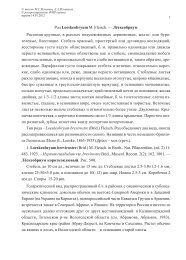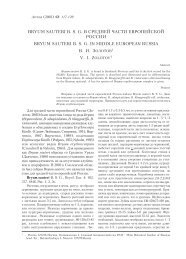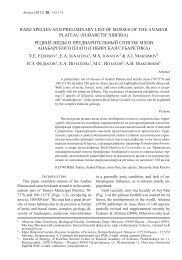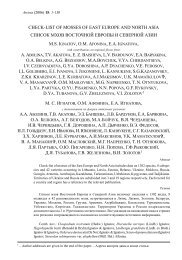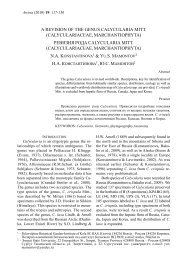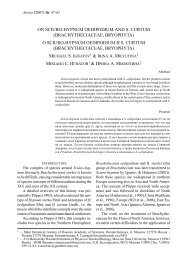THE GENUS BRYUM (BRYACEAE, MUSCI) IN MIDDLE ... - Arctoa
THE GENUS BRYUM (BRYACEAE, MUSCI) IN MIDDLE ... - Arctoa
THE GENUS BRYUM (BRYACEAE, MUSCI) IN MIDDLE ... - Arctoa
You also want an ePaper? Increase the reach of your titles
YUMPU automatically turns print PDFs into web optimized ePapers that Google loves.
202<br />
Habitat: In forest and steppe zones, on soil<br />
(sand, clay, peat), rocks, and old brick walls; often<br />
on dry slopes, in synantropic vegetation, sometimes<br />
in wet swamping and flooded meadows.<br />
Selected specimens examined (50): Arkhangelsk Prov.,<br />
Zickendrath 27.VII.1895, LE; Arkhangelsk Prov., Ignatov<br />
27.VIII.1988, MHA; Bashkortostan, Selivanova-Gorodkova,<br />
24.VII.1946, LE; Kaluga Prov., Nikolskij 28.VII.1911, LE;<br />
Moscow Prov., Ignatov 16.VII.1987, MHA; Nizhnij<br />
Novgorod Prov., Shvezov #81, LE; Tatarstan, Vereteinov<br />
6.V.1911, LE; Volgograd Prov., Ignatov 6.VIII.1999, MHA.<br />
Bryum creberrimum Tayl., London J. Bot. 5:<br />
54. 1846. Fig. 87,89<br />
Bryum affine Lindb. et H. Arnell, Kongl. Sv.<br />
Vet. Acad. Handl. 23(10): 43. 1890.<br />
Synoicous; antheridia large, purple, terminal and<br />
sometimes single antheridia in axils of upper leaves;<br />
antheridia and paraphyses numerous, paraphyses<br />
yellow to red, to twice as long as antheridia.<br />
Plants in low, rather dense tuft 1-2 cm high,<br />
green, densely tomentose, rhizoids ferrugineousbrown,<br />
papillose. Stem red, to 1 cm long, comose,<br />
subterminal shoots (1-)2-4(-6), to 0.5 cm long,<br />
comose. Lower leaves 2.0-2.2 mm long, 0.8-1.0<br />
wide, ovate, shortly acuminate to ovate-lanceolate<br />
and longly acuminate; costa percurrent to excurrent.<br />
Upper leaves spreading when wet, imbricate<br />
when dry, sometimes slightly twisted around stem<br />
and curved, 3.0-3.9 mm long, 1.0-1.4 mm wide,<br />
ovate-lanceolate, broadest at 1/5-1/3 of leaf<br />
length, gradually longly acuminate, +shortly decurrent,<br />
red at base; leaf margin reflexed to revolute<br />
from base to acumen, entire to weakly serrulate<br />
above; border narrow, (1-)2-3(-4)-rowed, unistratose,<br />
yellow, distincly delimited; costa rather<br />
stout, at base red to bright-red, usually longly<br />
decurent, above yellow-green, in acumen to brownish,<br />
excurrent in smooth or weakly serrulate stout<br />
0.20-0.40(-0.65) mm long awn. Laminal cells thinwalled,<br />
slightly porose, in upper leaf rhomboidhexagonal<br />
and rhomboid, 50-60(-70) x 12-16(-<br />
20) μm, in mid-leaf (24-)48-52(-60) x (12-)16-<br />
20(-24) μm, at base long rectangular (64-)88(-92)<br />
x (20-)24(-28) μm, in leaf corners long rectangular<br />
to 80 μm long and 20 μm wide in distinctly<br />
decurrent leaves or shorter and slightly inflated,<br />
to 44 μm wide in slightly decurrent leaves.<br />
Perichaetial leaves ovate, with long piliferous<br />
V. I. ZOLOTOV<br />
acumen and costa ending in acumen, margin plane.<br />
Seta (1.5-)2-3(-6) cm, orange-red, red or fuscous,<br />
rigid, not twisted when dry, below capsule abruptly<br />
hooked. Capsule horizontal, inclined to pendulous,<br />
brown to fuscous, 2.0-4.0(-4.5) mm long, 1.0-1.5<br />
mm thick, narrow-cylindric to cylindric, oblong clavate<br />
or kegel-shaped, symmetric, slightly contracted<br />
below mouth when dry; neck as long or somewhat<br />
shorter than urn, collapsed when dry or not. Operculum<br />
large, plane-convex to convex, with short<br />
acute apiculus, of the same color as capsule or brighter,<br />
glossy. Annulus to 120 μm broad, 2-3-rowed. Peristome<br />
inserted at urn mouth, 450-700 μm high. Exostome<br />
teeth holodontous, rarely aulacodontous, at<br />
base 100-140 μm wide, below yellow, in uppermost<br />
part hyaline; border broad 16-20 μm; median line<br />
often nearly straight; fundus orange, 72-84 μm high,<br />
broadened; ventral trabeculae 27-30. Endostome free,<br />
yellowish, basal membrane 1/2 of endostome length;<br />
segments broad, half-segnment at base 52-60 μm<br />
wide, broadly perforate below, narrowly split above;<br />
cilia (2-)3(-4), long, papillose, longly appendiculate.<br />
Spores 12-16(-22) μm, yellow.<br />
Differentiation: The differences from B.<br />
lonchocaulon and B. bimum are discussed under<br />
both.<br />
Habitat: On wet and moist soil, peat, eroded<br />
chalk and limestome mixed with humus, rarely<br />
on rotten wood; in swamps, meadows, meadowsteppes,<br />
and secondary vegetation.<br />
Selected specimens examined (60): Arkhangelsk<br />
Prov., Zickendrath #1179, LE; Bashkortostan,<br />
Selivanova-Gorodkova #68, LE; Belgorod Prov.,<br />
Popova 17.VIII.1994, VOR; Kaluga Prov., Nikolskiy<br />
29.VII.1911, LE; Moscow Prov., Zickendrath # 463,<br />
LE; Nizhnij Novgorod Prov., Shvezov #109, LE;<br />
Voronezh Prov., Popova 3.IX.1982, VOR; Yaroslavl<br />
Prov., Zickendrath 31.V.1891, LE.<br />
Bryum bimum (Schreb.) Turn., Muscol. Hibern.<br />
Spic. 127. 1804. – Mnium bimum Schreb.,<br />
Bot. Zeitung 1: 79. 1802. – Bryum pseudotriquetrum<br />
var. bimum (Schreb.) Lilj., Utkast Sv.<br />
Fl. 3: 553. 1816. Figs. 90-91<br />
Synoicous; antheridia and paraphyses numerous,<br />
red, longer than antheridia.<br />
Plants in wide, compact to dense tufts 2-3(-<br />
6) cm high, green, fuscous-green, brownish-green,<br />
and +red inside, densely tomentose, rhizoids red-<br />
Fig. 88. Bryum lonchocaulon C. Muell. (from Ufa, Podpera, 10.VIII.1917, LE): 1-2 – capsules; 3 – habit; 4 – annulus;<br />
5 – outer surface of exostome tooth; 6 – inner surface of exostome tooth; 7 – part of endostome; 8-9 – perigonial leaves;<br />
10-11 – perichaetial leaves; 12-13 – transverse leaf section; 14 – mid-leaf cells; 15 – upper laminal cells; 16-20 – leaves;<br />
21 – basal cells. Scale bars: 2 mm for 1-3; 1 mm – 8-11, 16-20; 200 μm – 4, 12-15; 100 μm – 5-7.



